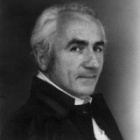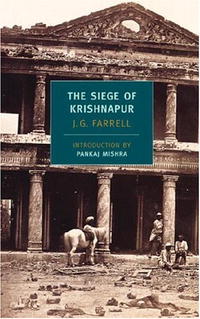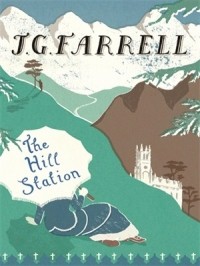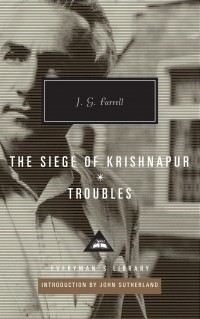
Джеймс Гордон Фаррелл — об авторе
- Родился: 25 января 1935 г. , Ливерпуль, Великобритания
- Умер: 11 августа 1979 г. , Ирландия
Биография — Джеймс Гордон Фаррелл
Джеймс Гордон Фаррелл (Дж. Г. Фаррелл) (James Gordon Farrell) - романист ирландского происхождения, родившийся в Ливерпуле. Известность ему принесла серия романов – трилогия «Империя» (романы Проблемы, Осада Кришнапура и Захват Сингапура), развивающая вопросы политических и социальных (человеческих) последствий колониального господства Великобритании.
Карьера Фаррелла трагично оборвалась: в возрасте 44 лет автор упал со скалы во время шторма и утонул (в Ирландии). В 2008 году Салман Рушди отметил: "Если бы его жизнь так печально не оборвалась, когда он был еще такой молодой, на сегодня он, безусловно, был бы одним из действительно крупнейших романистов англоязычного мира. Те три романа,…
которые он нам оставил, каждый по-своему исключительны".
Farrell, born in Liverpool into a family of Anglo-Irish background, was the second of three brothers. His father, William Farrell, had worked as an accountant in Bengal and in 1929, he married Prudence Josephine Russell, who was a former receptionist and secretary to a doctor. From the age of 12 he attended Rossall public school in Lancashire. After World War II, the Farrells moved to Dublin, and from this point on Farrell spent much time in Ireland: this, perhaps combined with the popularity of Troubles, leads many to treat him as an Irish writer. After leaving Rossall, he taught in Dublin and also worked for some time on Distant Early Warning Line in the Canadian Arctic. In 1956 he went to study at Brasenose College, Oxford; while there he contracted polio. This would leave him partially crippled and disease would be prominent in his works. In 1960 he left Oxford with Third-class honours French and Spanish and went to live in France, where he taught at a lycée.
Farrell published his first novel, A Man From Elsewhere, in 1963. Set in France, it shows the clear influence of French existentialism. The story follows Sayer, who is a journalist for a communist paper, as he tries to find skeletons in Regan's closet. Regan is a dying novelist who is about to be awarded an important Catholic literary prize. The book mimics the fight between the two leaders of French existentialism: Jean-Paul Sartre and Albert Camus (Sayer representing Sartre and Regan representing Camus). The two argue about existentialism: the position that murder can be vindicated as an expedient in overthrowing tyranny (Sartre) versus the stance that there are no ends that justify unjust means (Camus). Bernard Bergonzi reviewed it in the New Statesman in the September 20, 1963 issue and said, "Many first novels are excessively autobiographical, but A Man from Elsewhere suffers from the opposite fault of being a cerebral construct, dreamed up out of literature and the contemporary French cinema." Simon Raven wrote in The Observer on September 15, 1963 that "Mr. Farrell's style is spare, his plotting lucid and well timed; his expositions of moral or political problems are pungent if occasionally didactic." It entirely lacks the ironic humour and the tender appreciation of human frailty which characterise his later work. Farrell himself came to dislike the book.[citation needed]
Two years after this came The Lung, in which Farrell returned to his real-life trauma of less than a decade earlier: the main character Martin Sands contracts polio and has to spend a long period in hospital. It has been noted that it is somewhat modeled after Farrell, but it is modeled more after Geoffrey Firmin from Malcolm Lowry 1947 novel, Under the Volcano. The anonymous reviewer for The Observer on October 31, 1965, wrote that "Mr. Farrell gives the pleasantly solid impression of really having something to write about" and one for The Times Literary Supplement on November 11, 1965 that "Mr. Farrell's is an effective, potent brew, compounded of desperation and a certain wild hilarity."
In 1967 he published A Girl in the Head. The protagonist, the impoverished Polish count Boris Slattery, lives in the fictional English seaside town of Maidenhair Bay, in the house of the Dongeon family (which is believed to be modeled after V. S. Naipaul's A House for Mr Biswas). His marriage to Flower Dongeon is decaying. His companion is Dr. Cohen, who is a dying alcoholic. Boris also has sex with an underaged teenager, June Furlough. He also fantasizes about Ines, a Swedish summer guest, who is the "girl in the head". Boris is believed to be modeled after Humbert Humbert in Vladimir Nabokov's Lolita. Like its two predecessors, the book met only middling critical and public reaction. In the July 13, 1967 issue of The Listener, Ian Hamilton wrote that he disliked the novel, and thought it was, at best, an "adroit pastiche" of Samuel Beckett's deadbeats. Martin Levin wrote in The New York Times Book Review on March 23, 1969, that he praised the author's "flair for giving the ridiculous an inspired originality". In an anonymous review in The New York Times Book Review on July 20, 1967, the writer stated that the "verbal assurance and resourcefulness show that Mr. Farrell is not content to coast along merely imitating his previous work. Such a deliberate extension of range is perhaps a hopeful sign for a talent which, after three novels, still has not found the mode in which to fulfil its attractive promise."
Troubles tells the comic yet melancholy tale of an English Major, Brendan Archer, who in 1919 goes to County Waterford in Ireland to meet the woman he believes he may be engaged to marry. From the crumbling Majestic Hotel at Kilnalough, he watches Ireland's fight for independence from Britain. Farrell started writing this book while on a Harkness Fellowship in the United States and finished it in a tiny flat in Knightsbridge, London. He got the idea for the setting from going to Block Island and seeing the remains of an old burned-down hotel. He won a Geoffrey Faber Memorial Prize for the novel, and with the prize money travelled to India to research his next novel.
Farrell's next book The Siege of Krishnapur and his last completed work The Singapore Grip both continue his story of the collapse of British colonial power. The former deals with the Indian Rebellion of 1857. Inspired by historical events such as the sieges of Cawnpore and Lucknow, the novel is set in the fictional town of Krishnapur, where a besieged British garrison succeeds in holding out for four months against an army of native sepoys, in the face of enormous suffering, before being relieved.
The third of the novels, The Singapore Grip, centers upon the Japanese capture of the British colonial city of Singapore in 1942, while also exploring at some length the economics and ethics of colonialism at the time, as well as the economic relationship between developed and Third World countries at the time that Farrell was writing.
The three novels are in general linked only thematically, although Archer, a character in Troubles, reappears in The Singapore Grip. The protagonist of Farrell's unfinished novel, The Hill Station, is Dr McNab, introduced in The Siege of Krishnapur; this novel and its accompanying notes make the series a quartet.
When The Siege of Krishnapur won the Booker Prize in 1973, Farrell used his acceptance speech to attack the sponsors, the Booker Group, for their business involvement in the agricultural sector in the Third World. In this vein, some readers have found Farrell's critique of colonialism and capitalism in his subsequent novel The Singapore Grip to be heavy-handed, although those new to the book after the crash of 2008 might not find it so.
Charles Sturridge scripted a film version of Troubles made for British television in 1988 and directed by Christopher Morahan.
In 1979 Farrell decided to quit London to take up residence on the Sheep's Head peninsula in southwestern Ireland. A few months later he was found drowned on the coast of Bantry Bay, apparently from falling in from rocks while angling. He was 44. He is buried in the cemetery of St. James's Church of Ireland church in Durrus.
The manuscript library at Trinity College, Dublin holds his papers: Papers of James Gordon Farrell (1935–1979). TCD MSS 9128-60.
Книги
Смотреть 10Библиография
1963 A Man From Elsewhere
1965 The Lung
1967 A Girl in the Head
1981 The Hill Station
Empire Trilogy (Имперская трилогия):
1970 Troubles
1973 The Siege of Krishnapur // Осада Кришнапура
1978 The Singapore Grip // Захват Сингапура
Early works
A Man From Elsewhere (1963)
The Lung (1965)
A Girl in the Head (1967)
Empire Trilogy
Troubles (1970)
The Siege of Krishnapur (1973)
The Singapore Grip (1978)
Published posthumously
1973-74: The Pussycat Who Fell in Love with a Suitcase.
1981: The Hill Station; and An Indian Diary, unfinished.
Интересные факты
В 2010 г., через 40 лет после первой публикации роман «Проблемы» (Troubles) Джеймса Гордона Фаррелла (J.G. Farrell) награжден премией Букер. Приз за британского писателя, умершего в 1979 году, на церемонии в Лондоне получил его брат.
Титулы, награды и премии
1970 Lost Man Booker Prize - Букеровская премия - роман "Troubles", присвоена в 2010 г.
1971 Geoffrey Faber Memorial Prize - мемориальная премия Джеффри Фабера - роман "Troubles"
1973 Букеровская премия - роман "Осада Кришнапура"
1970 Lost Man Booker Prize (Troubles) awarded in 2010
1971 Geoffrey Faber Memorial Prize (Troubles)
1973 Booker Prize (The Siege of Krishnapur)
Премии
Ссылки
Рецензии
Смотреть 82 мая 2012 г. 09:41
321
5
Anyone who has never before visited Krishnapur, and who approaches from the east, is likely to think he has reached the end of his journey a few miles sooner than he expected.
Есть романы, получившие Букеровскую премию, которые у всех на слуху, а есть романы, которые, несмотря на Букеровку, как-то менее известны.
Странно, но замечательный роман Фарелла "Осада Кришнапура" относится к разряду именно таких, менее известных романов несмотря на:
1. Роман в списке 1001 книга 2. Роман в списке 1000 книг газеты Гардиан 3. Роман не только получил Букеровскую премию 1973 года, но и вышел в шестерку финалистов на премию "The Best of the Booker" в 2008 году.
Итак, "Осада Кришнапура". В этом романе та самая удивительная сместь психологизма и сатиры, юмора, которые я очень люблю. Как рассказать об…
14 декабря 2017 г. 10:26
446
4.5 Осада Кришнапура
Вторая часть "Имперской трилогии" Фаррелла - об Индии. А конкретно - она основывается на истории восстания сипаев в середине XIX века, и в частности осаде Лакхнау. Лично у меня с историей в школе складывалось не очень, но эту я помню хорошо: всё началось с того, что оболочки патронов для винтовок, которыми британцы вооружили подневольную им индийскую армию, были пропитаны животным жиром, а разрывать их предполагалось зубами. Индусы, узнав об этом, и подняли восстание. В школе мне было сложно понять вегетарианство как идею, но пределом глупости было именно поведение британцев: зачем они стали рубить сук, на котором сидели? Именно эту идею и прощупывает Фаррелл в своей трилогии. Британцы были несустветными снобами, которые считали себя единственными на свете знатоками всего, а остальное…










